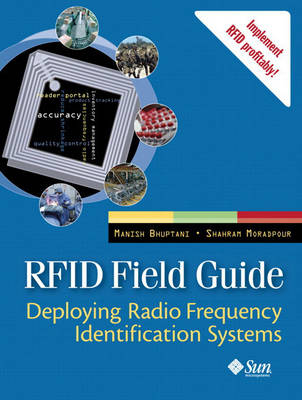
RFID Field Guide
Prentice Hall (Verlag)
978-0-13-185355-3 (ISBN)
- Titel ist leider vergriffen;
keine Neuauflage - Artikel merken
The RFID Field Guide is a comprehensive source of practical advice fordesigning and deploying RFID systems in a variety of industries andapplications. It features real-life examples, case studies and frameworks thatdemonstrate how to successfully deploy RFID solutions. In addition toconcisely explaining the fundamentals of the technology, Moradpour andBhuptani carefully analyze RFID's capabilities, possibilities and businessadvantages, and describe a process for evaluating the costs and benefits ofRFID projects. They also address issues related to compliance with variousmandates, security and privacy. Appropriate for those new to the technologyand those already starting to work with and evaluate RFID, this book is a fieldguide for the practitioner to gain a detailed understanding of the technology orsimply get answers to specific questions.
ABOUT THE AUTHORS Shahram Moradpour is CEO and co-founder of Cleritec Systems based in Silicon Valley. Cleritec provides RFID solutions for manufacturing, retail, and healthcare companies. Prior to Cleritec, Shahram was Senior Director of Market Development at Sun Microsystems where he oversaw Sun's alliances with more than 450 partners. He also sponsored and directed numerous emerging technology projects with Fortune 500 companies. He holds Master and Bachelor of Science degrees in Computer Science from UCLA. Manish Bhuptani is President and co-founder of Cleritec Systems. Prior to Cleritec he was Director of Market Development at Sun Microsystems where he grew Sun's market presence in emerging and established markets. He has also worked as a management consultant at A.T. Kearney where he advised Fortune 500 companies on business strategy, and as a software engineer at IBM. He holds an MBA from the University of California, Berkeley, an MS in Computer Engineering from Purdue University, and a BE in Electrical Engineering from The Cooper Union. © Copyright Pearson Education. All rights reserved.
Contents
About the Authors.
Preface.
I. WHAT IS RFID?
1. A Better Wayof Doing Things.
Security and Authentication
Electronic Article Surveillance
Document Authentication
Access Control
Electronic Drug Pedigree
Safety
People Monitoring
Patient Care
Environmental Sensing and Monitoring
Convenience
Payment and Loyalty
Crowd Control
Sports Timing
Golf Ball Tracking
Process Efficiency
Track and Trace
Industrial Automation
Supply Chain Integration
Summary
2. The History and Evolution of RFID.
RFID Technology and the Radio
The Early Days of RFID
From Detection to Unique Identification
RFID Flourishes Across the Globe
Texas Instruments Leads Pioneering Efforts in the U.S.
Europe Gets an Early Start
Passive Tags Grow Up in the ’90s
Summary
3. Components of RFID Systems.
Operational Description of RFID Systems
Hardware Components
Tag
Reader
Antenna
Limitations of Tag and Reader Communications
Host Computer
Software Components
RFID System Software
RFID Middleware
Host Application
The EPCglobal Network
Electronic Product Code (EPC)
The ID System
EPC Middleware
Object Name Service (ONS)
EPC Information Services (EPCIS)
Summary
II. HOW TO DEPLOY RFID.
4. Standards Related to RFID.
Role of Standards in Technology Advancement and Adoption
Standards and RFID–An Overview of EPCglobal
Version 1.0/1.1 Specifications
Implementation of EPC through EPCglobal Network
Functions and Features of EPCglobal
ISO and RFID Standards
Other Standardization Initiatives
Recommendations for the Practitioner
Summary
5. Framework for Deployment.
Introducing RFID Deployment Framework
Identify Business Problem
Define and Pilot Solution
Build and Deploy Solution
Sustain and Improve
Knowledge Base
Summary
6. Organizational Mobilization.
Achieving Organizational Mobilization
Provide Leadership Focus
Communicate Shared Vision
Engage Support and Resistance
Institutionalize Results and Lessons
Summary
7. Cost-Benefit Analysis.
Analyzing Benefits
Types of Benefits
Finding the Right Benefit Level
Elements of Cost
Tags
Readers
Antennae
Host Computer, Middleware, and Host Applications
Installation
Tuning
Integration and Business Process Reengineering
Support and Maintenance
Cost-Benefit Characterization of Selected Applications
Summary
8. Vendor Considerations and Landscape.
Vendor Selection Approach
Best-of-Breed
One-Stop-Shop
Trusted Advisor
Vendor Comparison Criteria
Vendor Categories
Tag and Reader Vendors
RFID Middleware Vendors
Computer Systems Vendors
Application Vendors
Systems Integration Vendors
Value Added Vendors
Specialty Services Vendors
Vendor Guide
Summary
III. THE PATH AHEAD.
9. Mandates as Business Catalysts.
Wal-Mart and RFID
Background
Wal-Mart Mandate
Implications for Suppliers
Implications for RFID Component Vendors
U.S. Department of Defense and RFID
Details of the Mandate
Implications for Suppliers
Recommendations for Suppliers of Wal-Mart, Other Retailers, and the DoD
RFID Initiatives at Other Organizations
Summary
10. Security and Privacy.
Distinguishing Between Security and Privacy Issues
Security Challenges
Areas of Security Vulnerability in RFID Components
Assessing Security Risks in RFID Applications
Solutions for Securing and Protecting RFID Data
Privacy Considerations
Consumer RFID Applications and Privacy
Consumer Willingness to Disclose Personal Data
RFID Privacy Best Practices
Summary
11. Emerging Trends in RFID.
Technological Advancements
New and Improved Tags
Architecture for the New Network
Falling RFID Tag Price
Business Process Innovations
Item-Level Tagging
Third-Party Logistics Management
Real-Time Inventory Management
Business Intelligence
IT Outsourcing
Real-Time Data Sharing for Total Supply Chain Integration
Evolving Standards and Legislation
Industry Standards
Government Regulations and Mandates
Privacy Related Regulations
Consumer Application Innovations
Summary
Appendix A.
Case Study: Michigan Department of Agriculture
Case Study: Sun Microsystems
Case Study: Operation Enduring Freedom/Operation Iraqi Freedom (OEF/OIF)
Case Study: Woolworths, Plc.
Case Study: Smart & Secure Tradelanes– Phase One Review
Appendix B: The Sun EPCglobal Network Architecture.
References and Recommended Reading
Index.
| Erscheint lt. Verlag | 17.2.2005 |
|---|---|
| Verlagsort | Upper Saddle River |
| Sprache | englisch |
| Maße | 175 x 232 mm |
| Gewicht | 540 g |
| Themenwelt | Technik ► Elektrotechnik / Energietechnik |
| Technik ► Nachrichtentechnik | |
| ISBN-10 | 0-13-185355-4 / 0131853554 |
| ISBN-13 | 978-0-13-185355-3 / 9780131853553 |
| Zustand | Neuware |
| Haben Sie eine Frage zum Produkt? |
aus dem Bereich


